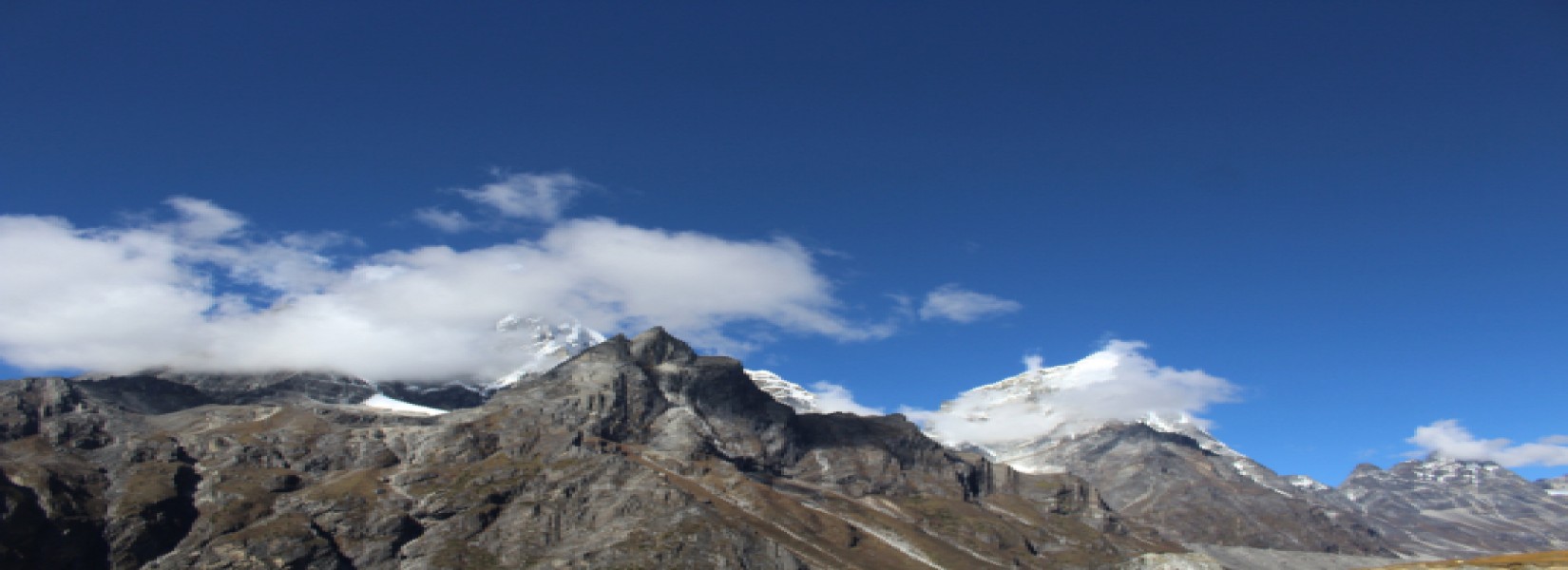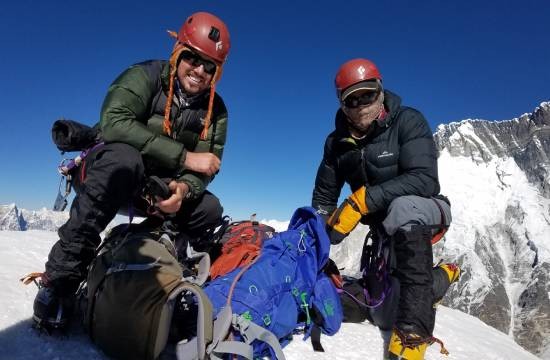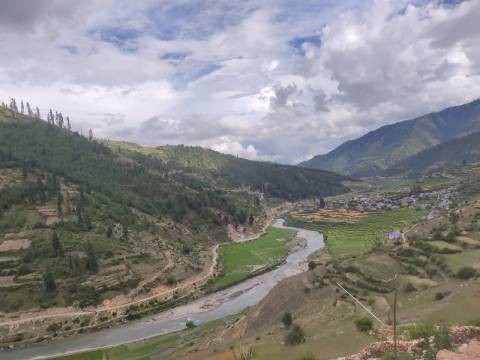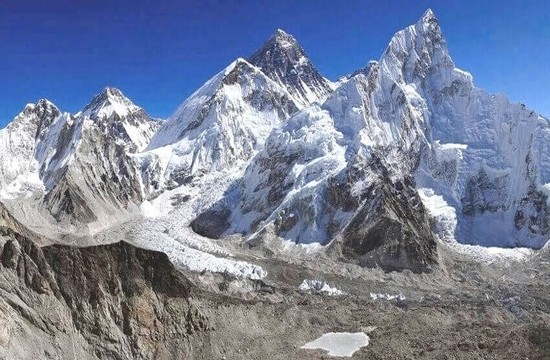The autumn season, which normally lasts from September to November, is regarded as one of the greatest seasons to visit Everest Base Camp. As opposed to the peak trekking months in spring, the trails to Everest Base Camp are often less congested during the autumn season. With fewer trekkers on the path, you may enjoy a more tranquil and serene experience. Because they are less damaged by snow and rain, the trails are well-defined and easier to travel.
Table of Content
Everest Base Camp Trek in Autumn
Embark on a breathtaking adventure Everest Base Camp Trek through the rugged terrain of the Himalayas as you venture towards the majestic Everest Base Camp. Nestled in the heart of Nepal, this iconic trek promises an experience like no other. As you lace up your boots and take the first step, prepare to be captivated by a blend of natural wonders and cultural treasures that will leave you spellbound.

Everest Base Camp Autumn Season
Situated at an awe-inspiring elevation of 5,364 meters (17,598 feet), Everest Base Camp serves as a gateway to the world's tallest peak, Mount Everest. This legendary mountain, soaring at a majestic height of 8,848 meters (29,029 feet), stands tall as the pinnacle of human achievement. As you ascend through the mesmerizing Khumbu Valley, the surrounding peaks gradually reveal their magnificence, forming a panorama of snow-capped giants that touch the heavens.
The Everest Base Camp trek commences in Lukla, a quaint town perched at an elevation of 2,860 meters (9,383 feet). From here, you traverse a network of trails, guided by the rhythm of your footsteps and the breathtaking landscapes that unfold with each passing day. The journey takes you through the enchanting Sagarmatha National Park, a UNESCO World Heritage site renowned for its remarkable biodiversity and rich cultural heritage.
Sagarmatha National Park, spanning an area of 1,148 square kilometers (443 square miles), is a sanctuary for diverse flora and fauna. Home to rare species like the snow leopard, red panda, and Himalayan monal, it offers a glimpse into the wonders of the natural world. As you wander through the park's lush forests, you'll be greeted by the melodious chirping of birds and the fragrance of wildflowers, creating a symphony of senses that heightens the allure of your expedition.
Along the Everest Base Camp Region Trekking Trail, you'll encounter vibrant Sherpa villages, where warm smiles and friendly faces welcome weary travelers. These resilient mountain communities have cultivated a unique way of life, deeply rooted in their spiritual beliefs and mountaineering traditions. Interacting with the locals and immersing yourself in their rich cultural tapestry will undoubtedly leave an indelible mark on your journey.
As you continue your ascent, you'll reach key landmarks such as Namche Bazaar, the bustling heart of the Khumbu region, and Tengboche Monastery, a sacred haven perched at 3,867 meters (12,687 feet) that offers panoramic views of Everest and its neighboring peaks. Each step brings you closer to your ultimate destination, Everest Base Camp, where you stand in awe of the colossal mountain that has beckoned adventurers for centuries.
The Everest Base Camp trek is not merely a physical conquest but a spiritual and emotional odyssey. It challenges your limits, rewards your perseverance, and unveils the raw beauty of nature in its purest form. So, lace up your boots, embrace the unknown, and embark on a journey that will leave an indelible mark on your soul—a journey to the roof of the world.

Everest Base Camp Autumn Season View
As you ascend through the mesmerizing Khumbu Valley, the surrounding peaks gradually reveal their magnificence, forming a panorama of snow-capped giants that touch the heavens. Towering over the landscape is the legendary Mount Everest, standing tall at 8,848 meters (29,029 feet), the highest peak on Earth. Its majestic presence dominates the horizon, commanding both awe and respect.
But Mount Everest is not the sole star of this majestic ensemble. Along the trek, you'll be treated to breathtaking views of neighboring peaks such as Lhotse, the fourth-highest mountain in the world, soaring to an impressive 8,516 meters (27,940 feet). The distinctive pyramid shape of Nuptse, standing at 7,861 meters (25,791 feet), adds a touch of grandeur to the surrounding landscape. Ama Dablam, with its elegant and symmetrical form, stands as a testament to the exquisite beauty of the Himalayas.
As you make your way through the rugged terrain, the captivating sights of Thamserku, Kangtega, and the mighty Cho Oyu will leave you in awe of nature's artistic prowess. These towering giants, clad in glistening snow and bathed in ethereal light, create a canvas of breathtaking beauty that transcends words.
With each step forward, the ever-changing vistas continue to unfold. The beauty of the Himalayas reveals itself in every direction, captivating your senses and evoking a sense of reverence for the raw power and sublime serenity of these ancient mountains.
Everest Base Camp Trek can fully be entertained in two best times of the year: Autumn( Sept.-Nov) and Autumn ( Mar-May). First, people choose to do Everest Base Camp Trek in Autumn and if they cannot do it in Autumn, they switch it to Spring. However, trekkers try their best to make it happen in Autumn since it is the best time of the year for undertaking Everest Base Camp Trek.
Everest Base Camp Trek in Autumn
Embarking on the Everest Base Camp Trek in the vibrant season of autumn is an awe-inspiring journey that immerses you in a symphony of colors, breathtaking landscapes, and a profound sense of adventure. As you set foot on the trail, you're greeted by a crisp, cool breeze carrying the scent of fallen leaves, filling the air with invigorating freshness.
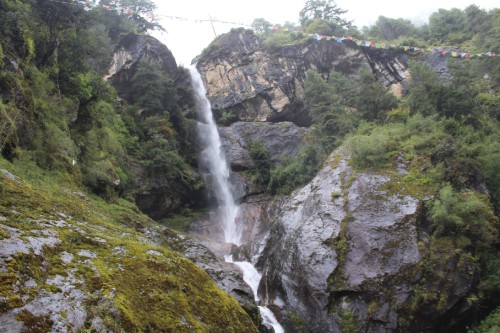
Best Weather Everest Base Camp Autumn
The Everest Base Camp Trekking trail in Autumn unfolds before you like a tapestry of natural wonders. The towering Himalayan peaks stand majestically, their snow-capped summits glistening under the golden rays of the sun. The surrounding valleys are painted in hues of red, orange, and yellow, as the foliage transitions into a kaleidoscope of autumnal shades. Every step reveals a captivating panorama that takes your breath away.
The Everest Base Camp Trekking trail in Autumn itself is a blend of challenge and serenity. You navigate through rugged terrain, crossing suspension bridges that sway gently above glacial rivers. As you ascend higher, the air becomes thinner, but the beauty that envelops you remains unparalleled. Along the way, you encounter remote Sherpa villages, where colorful prayer flags flutter in the wind, and the warm smiles of the locals create an atmosphere of genuine hospitality.
Reaching Everest Base Camp, you are rewarded with a spectacle that words cannot fully capture. The sight of the iconic Khumbu Icefall, the vast expanse of the Khumbu Glacier, and the towering presence of Mount Everest itself instills a profound sense of awe and accomplishment. Standing amidst this magnificent wilderness, you realize the sheer magnitude of nature's grandeur.
Autumn paints the Everest Base Camp Trek with an artist's touch, creating a vivid canvas that captivates the senses. It is a season that combines the thrill of adventure with the splendor of nature, etching memories that will forever remain imprinted in your heart.
Highlights
- Spectacular Mountain Views: Autumn is regarded as one of the greatest periods to walk to Everest Base Camp due to the normally clear and calm weather. The Himalayas' high peaks, including Mount Everest (8,848.86 meters/29,031.7 feet), Lhotse (8,516 meters/27,940 feet), Nuptse (7,861 meters/25,791 feet), and Ama Dablam (6,812 meters/22,349 feet), will provide stunning views. These breathtaking mountain peaks provide an outstanding backdrop for the walk to Everest Base Camp, making it a really unique experience.
- Pleasant Weather: During autumn (September to November), the temperatures in the Everest region are relatively mild, making trekking more enjoyable. The days are usually sunny and warm, with average temperatures ranging from 10 to 15 degrees Celsius (50 to 59 degrees Fahrenheit).
- Colorful and Incredible Landscapes: Autumn brings vibrant colors to the Everest region as the foliage turns golden and red. The forests and hillsides are adorned with colorful rhododendron blooms, adding a touch of beauty to the landscape.
- Festive Atmosphere/Mood: Autumn is a festive season in Nepal, and during your trek, you may encounter celebrations like Dashain and Tihar. These festivals provide a unique opportunity to experience the local culture, traditions, and rituals of the Sherpa people.
- Wildlife Encounters: Autumn is an excellent time for wildlife enthusiasts as the region's fauna becomes more active. You may spot various Himalayan wildlife, such as musk deer, Himalayan thar, snow leopards, and different species of birds, including the colorful Danphe (Himalayan Monal), during your trek.
Everest Base Camp Trek Autumn Season Itinerary
Day 1: Arrival in Kathmandu (1,400m/4,593ft)
Day 2: Kathmandu Sightseeing and Trek Preparation
Day 3: Fly to Lukla and Trek to Phakding (2,651m/8,700ft)
Day 4: Trek from Phakding to Namche Bazaar (3,438m/11,280ft)
Day 5: Acclimatization Day in Namche Bazaar
Day 6: Trek from Namche Bazaar to Tengboche (3,870m/12,694ft)
Day 7: Trek from Tengboche to Dingboche (4,360m/14,300ft)
Day 8: Acclimatization Day in Dingboche
Day 9: Trek from Dingboche to Lobuche (4,940m/16,207ft)
Day 10: Trek from Lobuche to Gorak Shep (5,164m/16,942ft) and Hike to Everest Base Camp (5,364m/17,598ft) and back to Gorak Shep
Day 11: Hike to Kala Patthar (5,545m/18,192ft) and Trek back to Pheriche (4,371m/14,340ft)
Day 12: Trek from Pheriche to Namche Bazaar (3,438m/11,280ft)
Day 13: Trek from Namche Bazaar to Lukla (2,860m/9,383ft)
Day 14: Fly from Lukla to Kathmandu (1,400m/4,593ft)
Note: This itinerary includes proper and sufficient time for acclimatization to prevent altitude sickness. It is recommended to follow the guidance of your trekking guide and doctor throughout the trek.
Level of Difficulty
The Everest Base Camp trek is a moderately challenging and awe-inspiring journey that takes you to the foot of the world's highest peak, Mount Everest. It requires physical fitness, mental stamina, and proper acclimatization due to the high-altitude environment. The trek starts at Lukla (2,860 meters) and gradually ascends through various villages and landscapes, offering breathtaking views of the Himalayas.
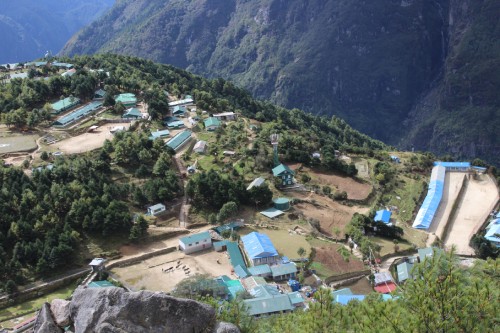
Everest Region In Autumn
The elevation ranges encountered during the Everest Base Camp trek are significant. The highest point reached on the trek is Kala Patthar, at 5,545 meters above sea level. This viewpoint offers a spectacular panoramic view of Everest and the surrounding peaks. The trek itself takes you through varied terrains, from lush forests to rocky moraines and icy glaciers, with altitude gains and losses along the way.
As you ascend, the air becomes thinner, making it harder to breathe. This is where proper acclimatization becomes crucial. Acclimatization days are built into the itinerary to allow your body to adjust to the increasing altitude and reduce the risk of altitude-related illnesses. These days involve shorter hikes at higher altitudes, allowing your body to adapt gradually.
The difficulty of the Everest Base Camp trek lies in the combination of the distance covered, the duration of the trek, and the high altitude. The trek can take around 12-14 days, depending on the itinerary chosen, and involves walking 4-7 hours per day on average. The steep ascents and descents, along with the endurance required for long hours of walking at higher altitudes, make it a physically demanding journey.
While the Everest Base Camp trek is challenging, it is also incredibly rewarding. The sense of accomplishment and the stunning vistas of the Himalayas make it a once-in-a-lifetime experience for many adventurers. Proper preparation, physical fitness, and mental determination are key to successfully completing this remarkable trek.
Weather and Temperature ranges
Autumn in Everest Base Camp Trek offers a unique blend of picturesque landscapes and favorable weather conditions. During this season, which typically spans from September to November, trekkers can expect clear skies, milder temperatures, and stable weather patterns.
The average daytime temperatures in the autumn range from 5 to 15 degrees Celsius (41 to 59 degrees Fahrenheit) at lower altitudes, gradually dropping as you ascend higher. Nights can be significantly colder, with temperatures ranging from -10 to 5 degrees Celsius (14 to 41 degrees Fahrenheit). However, the frigid temperatures of winter are yet to set in, making it a relatively comfortable period for trekking.
The weather is generally dry and stable, with fewer chances of rainfall compared to the monsoon season. The days are characterized by crisp and clear views of the Majestic Himalayan peaks, including Mount Everest. The vibrant autumn colors add an extra charm to the surrounding landscapes, making it a visually stunning experience.
It's important to note that temperatures and weather conditions can vary, so it's advisable to check the latest forecasts and be prepared for changes in weather during your Everest Base Camp Trek in autumn. Dressing in layers, carrying appropriate gear, and staying hydrated are essential for a safe and enjoyable trek.
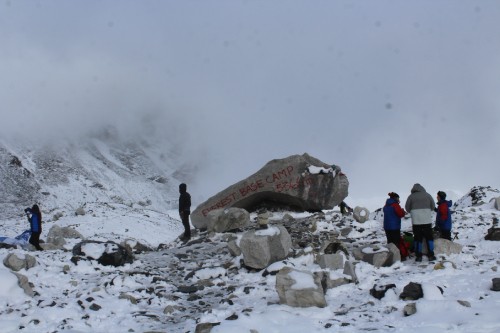
Everest Base Camp 5364 m in Atumun
Final Words
Definitely, Autumn is the best time of the year to do Everest Base Camp Trek. However, the Everest Base Camp Trekking Trail and the teahouses/guesthouses get crowded since large numbers of trekkers embark for Everest Base Camp. It means one may not like this trek in Autumn if you cannot tolerate a crowd of travelers on the trail and in the teahouses where you stay overnight. But, if you get the best experience and the achievement from Everest Base Camp Trek, then why not choose and plan the trek in Autumn? Go for your Everest Base Camp Trek in Autumn with Magic Expedition Tours and make it the adventure of a lifetime.
For More Details Please Kindly Contact Us:
